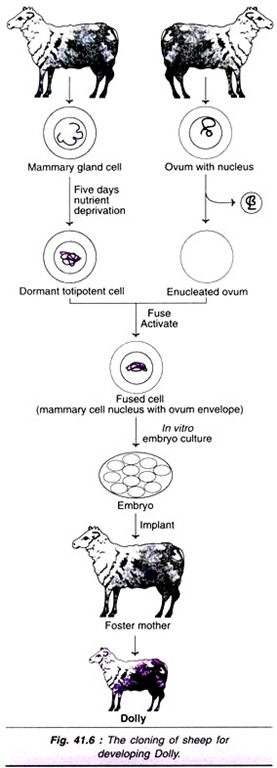ADVERTISEMENTS:
The clonal selection theory explains the mechanism by which the body’s immune system responds to the appearance of antigens present in or released from an agent of infection.
The immune system includes many millions of different clones of B and T lymphocytes, each clone consisting of cells that are capable of responding to the same form of antigen.
Thus, the body’s immune system is continuously “on alert” in anticipation of the appearance of any of more than a million different antigens. The immune response is triggered when antigens of the infecting agent become bound to immunoglobulin molecules in the plasma membranes of B cells or to T-cell receptors.
ADVERTISEMENTS:
Usually, a given antigen can be bound by the surface receptors of a number of different clones, but this is a tiny percentage of the total number of different clones present. Thus, the clones that respond to the presence of the antigen are, in effect, selected by the antigen, and this is what is meant by “clonal selection.”
Binding of antigen to the surface receptors of the cells of a particular B- or T-lymphocyte clone serves to activate these cells causing a succession of rounds of cell division that greatly increases the numbers of cells of that clone that are present in the body (Fig. 25-9). In the case of B cells, some of the progeny become plasma cells that synthesize and secrete quantities of antibody that will react with additional antigen; other progeny become memory cells that are reserved for a response to a subsequent exposure to the same antigen.
Some of the T-cell progeny also become memory cells, but most develop into the cytotoxic, helper, and suppressor cells responsible for the cell-mediated immune response. In Figure 25-9, which illustrates the principles of clonal selection, the antigen is shown to activate only one of the millions of B and T-cell clones present in the body.
ADVERTISEMENTS:
Activated B cells secrete antibodies, whereas activated T cells and un-activated B and T cells do not. It is therefore possible to distinguish activated B cells cytologically from activated T cells and virgin lymphocytes because activated B cells possess a well- developed rough endoplasmic reticulum (Fig. 25-10).
Antigenic Determinants and Haptens:
Most antigens are either proteins, polysaccharides, or nucleic acids, although it is likely that many other naturally occurring substances (especially those of high molecular weight) and even synthetic (i.e., man-made) materials can also act as antigens.
The specific region of the antigen that binds to a lymphocyte surface receptor or to an antibody is called the antigenic determinant. Large antigens may have several antigenic determinants. Some foreign substances can bind to an antibody or surface receptor and not elicit an immune response; such molecules are called haptens.
Haptens can be made antigenic by chemically coupling them to a carrier, such as a protein or polysaccharide. When haptens combine with some of the body’s own proteins, they may become antigenic and elicit an immune response that produces antibodies against the hapten.
Because a single antigenic determinant can react with more than one antibody, and because one antigen may possess more than one antigenic determinant, it follows that an antigen may activate several different lymphocyte clones. When a number of clones are activated, the response is said to be polyclonal. When only a few clones are activated, the response is said to be oligoclonal. When a single clone is activated, the response is monoclonal.

